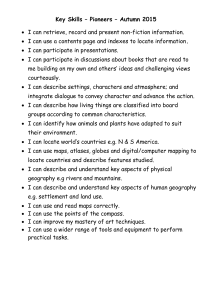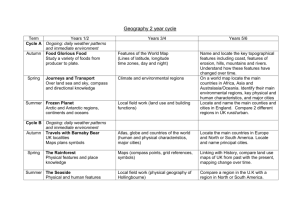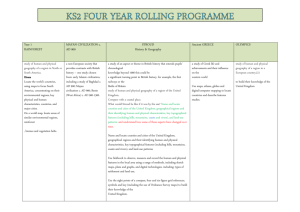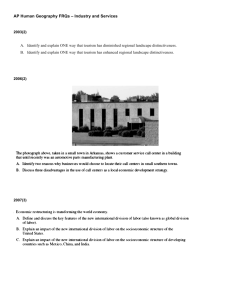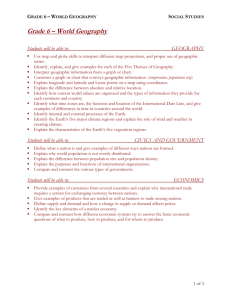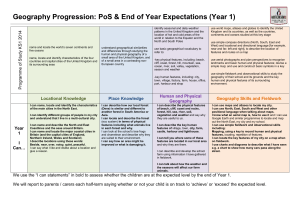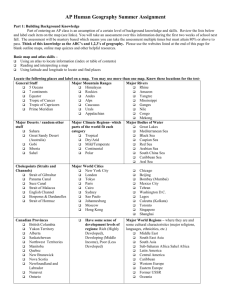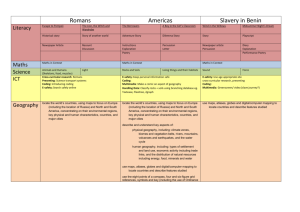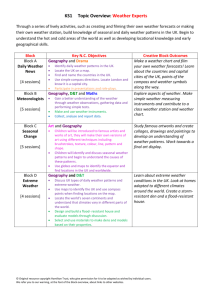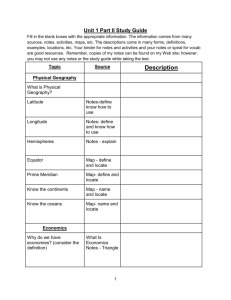Computing I can Grid Primary
advertisement
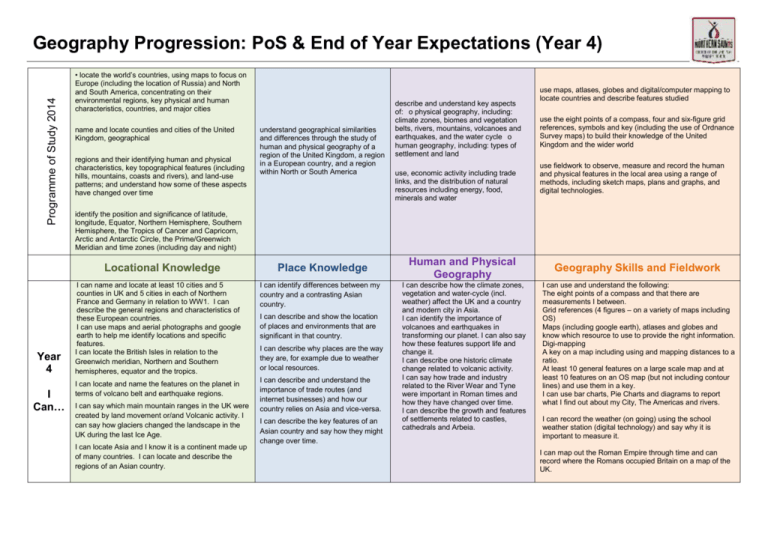
Programme of Study 2014 Geography Progression: PoS & End of Year Expectations (Year 4) • locate the world’s countries, using maps to focus on Europe (including the location of Russia) and North and South America, concentrating on their environmental regions, key physical and human characteristics, countries, and major cities name and locate counties and cities of the United Kingdom, geographical regions and their identifying human and physical characteristics, key topographical features (including hills, mountains, coasts and rivers), and land-use patterns; and understand how some of these aspects have changed over time I Can… use, economic activity including trade links, and the distribution of natural resources including energy, food, minerals and water use the eight points of a compass, four and six-figure grid references, symbols and key (including the use of Ordnance Survey maps) to build their knowledge of the United Kingdom and the wider world use fieldwork to observe, measure and record the human and physical features in the local area using a range of methods, including sketch maps, plans and graphs, and digital technologies. identify the position and significance of latitude, longitude, Equator, Northern Hemisphere, Southern Hemisphere, the Tropics of Cancer and Capricorn, Arctic and Antarctic Circle, the Prime/Greenwich Meridian and time zones (including day and night) Locational Knowledge Year 4 understand geographical similarities and differences through the study of human and physical geography of a region of the United Kingdom, a region in a European country, and a region within North or South America describe and understand key aspects of: o physical geography, including: climate zones, biomes and vegetation belts, rivers, mountains, volcanoes and earthquakes, and the water cycle o human geography, including: types of settlement and land use maps, atlases, globes and digital/computer mapping to locate countries and describe features studied I can name and locate at least 10 cities and 5 counties in UK and 5 cities in each of Northern France and Germany in relation to WW1. I can describe the general regions and characteristics of these European countries. I can use maps and aerial photographs and google earth to help me identify locations and specific features. I can locate the British Isles in relation to the Greenwich meridian, Northern and Southern hemispheres, equator and the tropics. I can locate and name the features on the planet in terms of volcano belt and earthquake regions. I can say which main mountain ranges in the UK were created by land movement or/and Volcanic activity. I can say how glaciers changed the landscape in the UK during the last Ice Age. I can locate Asia and I know it is a continent made up of many countries. I can locate and describe the regions of an Asian country. Place Knowledge I can identify differences between my country and a contrasting Asian country. I can describe and show the location of places and environments that are significant in that country. I can describe why places are the way they are, for example due to weather or local resources. I can describe and understand the importance of trade routes (and internet businesses) and how our country relies on Asia and vice-versa. I can describe the key features of an Asian country and say how they might change over time. Human and Physical Geography I can describe how the climate zones, vegetation and water-cycle (incl. weather) affect the UK and a country and modern city in Asia. I can identify the importance of volcanoes and earthquakes in transforming our planet. I can also say how these features support life and change it. I can describe one historic climate change related to volcanic activity. I can say how trade and industry related to the River Wear and Tyne were important in Roman times and how they have changed over time. I can describe the growth and features of settlements related to castles, cathedrals and Arbeia. Geography Skills and Fieldwork I can use and understand the following: The eight points of a compass and that there are measurements I between. Grid references (4 figures – on a variety of maps including OS) Maps (including google earth), atlases and globes and know which resource to use to provide the right information. Digi-mapping A key on a map including using and mapping distances to a ratio. At least 10 general features on a large scale map and at least 10 features on an OS map (but not including contour lines) and use them in a key. I can use bar charts, Pie Charts and diagrams to report what I find out about my City, The Americas and rivers. I can record the weather (on going) using the school weather station (digital technology) and say why it is important to measure it. I can map out the Roman Empire through time and can record where the Romans occupied Britain on a map of the UK. Geography Progression: PoS & End of Year Expectations (Year 4)
